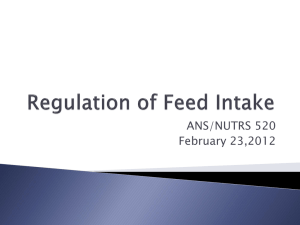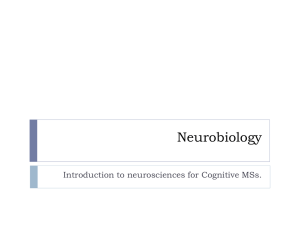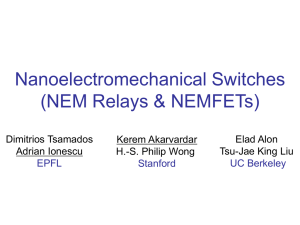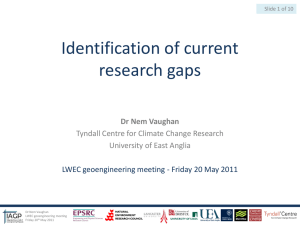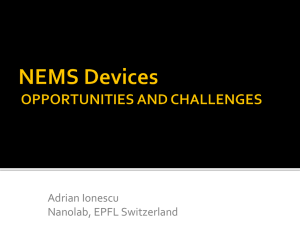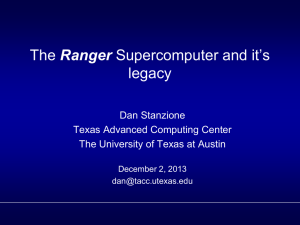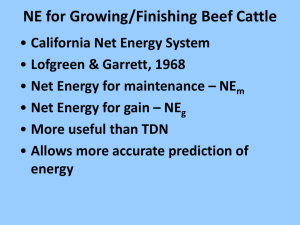NEM Skin - IETF Tools
advertisement
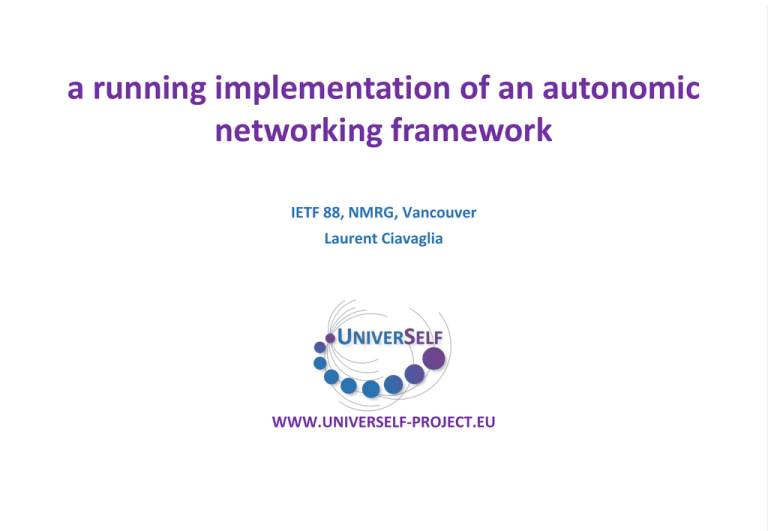
a running implementation of an autonomic networking framework IETF 88, NMRG, Vancouver Laurent Ciavaglia WWW.UNIVERSELF-PROJECT.EU STARTING POINT How to cope with networks ecosystem diversity? o Multiple types of autonomic function o Multiple technologies o Multiple roles, interactions, relationships Object Subject Subject Propositions: NEM Object NEM Object o Common “model” for autonomic functions Network Empowerment Mechanism (NEM) Subject NEM Subject NEM Object Object NEM NEM Subject NEM Domain Subject NEM Domain o Common “utility” functions Unified Management Framework (UMF) o UMF manages NEMs which (autonomously) control network resources o Put it in practice (cf. project demo track records) and share it IETF88, NMRG, Vancouver 2 FRAMEWORK AND EMPOWERMENT MECHANISMS NEM = an autonomic function controlling network resources NETWORK EMPOWERMENT MECHANISM (NEM) UNIFIED MANAGEMENT FRAMEWORK (UMF) NEM = use of relevant method to solve a concrete operational problem in a specific networking environment o e.g. use of genetic algorithm for interference coordination in LTE networks NEM SKIN = unified abstraction of NEM o common set of objects describing its properties and capabilities e.g. manifest, mandate, instance description o common set of interfaces to connect and interact with the UMF and other NEMs NEM SKIN = vector of unification, re-usable software component, and an accelerator for NEM implementation IETF88, NMRG, Vancouver 3 FRAMEWORK AND EMPOWERMENT MECHANISMS One framework to manage multiple/any types of NEMs NETWORK EMPOWERMENT MECHANISM (NEM) NETWORK Ability to cope withEMPOWERMENT NEM ecosystem diversity MECHANISM o heterogeneity of(NEM) NEM function/goal o multiple technology domains o multiple roles and interactions among NEMs with same model and interfaces (skin) NETWORK EMPOWERMENT MECHANISM (NEM) Specification of core utility functions, workflows and NEM lifecycle UNIFIED MANAGEMENT FRAMEWORK (UMF) IETF88, NMRG, Vancouver 3 core functions: o governance, coordination, knowledge o and associated mechanisms e.g. conflict avoidance, data mining… 4 FRAMEWORK AND EMPOWERMENT MECHANISMS UMF CORE GOVERNANCE NEM_x FB IETF88, NMRG, Vancouver KNOWLEDGE NEM_y FB method FB COORDINATION FB adaptor network element 5 UMF IN A NUTSHELL UMF CORE FUNCTIONAL BLOCKS Seamless deployment and trustworthy interworking of NEMs require: o Tools for the operators to deploy, pilot, control and track progress of NEMs in a unified way GOVERNANCE functional block o Tools to identify/avoid conflicts and ensure stability and performance when several NEMs are concurrently working COORDINATION functional block o Tools to make NEMs find, formulate and share relevant information to enable or improve their operation KNOWLEDGE functional block o APIs to enable NEMs “plug and play” deployment, interoperability and monitoring/configuration NEM Skin IETF88, NMRG, Vancouver 6 UMF IN A NUTSHELL NEM LIFECYCLE INSTALLED CREATE NEW INST. NEM Class (software) described by MANIFEST (machine readable) DELETE INSTANTIATED NEM Instance described by INSTANCE DESCRIPTION MANDATE DEPLOYING REVOKE Life-cycle: Detail the states and transition of a NEM instance, from its being installed, to it running its MAPE autonomic loop. REGISTERING INSTANCE DESCRIPTION READY SET UP SET DOWN Steps include all the management by the UMF core functional blocks. OPERATIONAL IETF88, NMRG, Vancouver 7 NEM SKIN Derives from the need for a common base for all NEMs o The UMF must be able to interact with NEMs for their deployment and operation as well as supply them with required inputs (operator’s goals/policies, mandate…) o Technological heterogeneity is abstracted at the NEM level while the required info/commands are propagated into the framework in a UMF-compliant way NEM Skin consists in o the specifications a NEM must meet (i.e. the interfaces and info exposed to UMF) o and the means to accomplish this (i.e. a REST-based API targeted for developers) Basic NEM Management Interface Generic sub-component (Handling of Messages/Policies, Controlling other nongeneric sub-components etc.) Non-generic sub-component (Decision making, Learning, Configuring etc.) … … Generic subcomponent (Knowledge Handling, Storing etc.) … Interface From/To equipment IETF88, NMRG, Vancouver Knowledge exchange Interface NEM SKIN Structure Overview UMF CORE GOV COORD KNOW Generic NEM functionality handling the manifest, mandate, registration, reception of policies, configuration options, actions, NEM state UMF compliance logic, interfaces and structure derived from UMF specifications and NEM model specifications NEM lifecycle-related events for the NEM developer and the management from UMF CORE Handling of Manifest/ Mandate Reception of Policies Exposing state, operation, and configuration -events Non-generic, vendor-specific logic IETF88, NMRG, Vancouver interface from/to equipment NEM Skin NEM NEM SKIN Structure Overview UMF CORE Generic NEM functionality GOV COORD KNOW CORE-to-NEM Interfaces handling the manifest, mandate, registration, reception of policies, configuration options, actions, NEM state UMF compliance logic, interfaces and structure derived from UMF specifications and NEM model specifications NEM lifecycle-related events for the NEM developer and the management from UMF CORE Interface definitions method/resource signatures NEM Management Interface Handling of Manifest/ Mandate Reception of Policies Knowledge Exchange Interface Exposing state, operation, and configuration -events Non-generic, vendor-specific logic IETF88, NMRG, Vancouver interface from/to equipment NEM Skin NEM NEM SKIN Structure Overview GOV UMF CORE COORD CORE-to-NEM Interfaces Generic NEM functionality handling the manifest, mandate, registration, reception of policies, configuration options, actions, NEM state UMF compliance logic, interfaces and structure derived from UMF specifications and NEM model specifications NEM lifecycle-related events for the NEM developer and the management from UMF CORE Interface definitions method/resource signatures Mechanism to handle the RESTful interfaces Not restricted to REST or JAVA IETF88, NMRG, Vancouver KNOW from the UMF core HTTP request-response paradigm to the UMF core JAVA binding to REST WS NEM Management Interface Handling of Manifest/ Mandate Reception of Policies Knowledge Exchange Interface Exposing state, operation, and configuration -events Non-generic, vendor-specific logic interface from/to equipment NEM Skin NEM NEM SKIN Development A JAVA package that implements: o the RESTful interfaces to/from the UMF Core, as well as some of the most critical aspects of the NEM model regarding the manifest, the mandate, the actions, information and configuration options. o the seamless driving of a NEM through it’s lifecycle (but with capabilities to intercept it) o additional abstraction over the HTTP details to provide with a REST-based RPC-invocation mechanism using regular JAVA code and compile-time binding o seamless publish/subscribe-over-HTTP support using regular JAVA events The final result is: o a single point of updating the UMF-related part of all NEMs o UMF compliance for the NEM developer without having to be aware of any protocolspecific details o an API that might potentially be used with a communication technology other than REST (future design choices might instruct so) IETF88, NMRG, Vancouver UMF IN A NUTSHELL UMF CORE FUNCTIONAL BLOCKS Seamless deployment and trustworthy interworking of NEMs require: o Tools for the operators to deploy, pilot, control and track progress of NEMs in a unified way GOVERNANCE functional block o Tools to identify/avoid conflicts and ensure stability and performance when several NEMs are concurrently working COORDINATION functional block o Tools to make NEMs find, formulate and share relevant information to enable or improve their operation KNOWLEDGE functional block o APIs to enable NEMs “plug and play” deployment, interoperability and monitoring/configuration NEM Skin IETF88, NMRG, Vancouver 13 UMF IN A NUTSHELL UMF CORE FUNCTIONAL BLOCKS Responsible for: The interaction between human operator and its network→ express business goals report on critical states of self-managed operations/devices Driving NEMs’ behavior→ policy-based framework for translating business-level, service specific goals/requests into low level, policies and configuration commands Functional decomposition GOVERNANCE NEM: Commands to set NEM’s status/mode (e.g. active, idle, stopped) and configure its operational parameters. Report on the NEM’s operational conditions and configuration characteristics (e,g. performance indicators, capabilities/behaviour, interaction with other NEMs). IETF88, NMRG, Vancouver 1 UMF / GOVERNANCE Interfaces Network Operator To edit, apply management policies, monitoring of the overall network performance and faults Set COORD policies (to COORD) Propagate operator objectives to be taken into account by coordination Call for Governance (from COORD) Alerts GOVERNANCE when e.g. a conflict cannot be resolved Requesting state information (from KNOW) To build an integrated view of the AFs /managed resources/service status KNOWLEDGE GOVERNANCE Instantiating, registering and deploying AFs To pilot the deployment of AFs and keep track on the configuration parameters (Mandate, Instance Description) AF_1 (new) IETF88, NMRG, Vancouver COORDINATION Running AFs : Activation/Deactivation Setting of new configuration parameters Reporting strategy AF_2 (running) UMF IN A NUTSHELL UMF CORE FUNCTIONAL BLOCKS Responsible for: Ensuring the proper sequence in triggering of NEMs and the conditions under which they will be invoked taking into account: Operator and service requirements, Needs for Conflict avoidance, joint optimization and stability control. Functional decomposition COORDINATION NEM: Commands to drive coordination including: tokens, timing, constraints, status (active/idle), etc. Information on the NEMs operation including: parameters, metrics, scope, utility functions, etc. IETF88, NMRG, Vancouver 1 UMF / COORDINATION Interfaces GOVERNANCE Call for Governance (from COORD) Alerts GOVERNANCE when e.g. a conflict cannot be resolved KNOWLEDGE COORDINATION Setting Policies to AF instances: • Regime Policies Used to give a token, or schedule the running of one or multiple AFs • Action Constraining Policies To enable/disable some of the potentially conflicting actions Registering AFs To get their instance descriptions AF_1 (registering) AF_2 (instance) Subscribing to AF instances available knowledge • Like “Predicted Utility” or “Measured Utility” AF_3 (operational) IETF88, NMRG, Vancouver Enforcing AF action to a given AF • Like demanding a AF to set a given value to an equipment parameter UMF IN A NUTSHELL UMF CORE FUNCTIONAL BLOCKS Responsible for: Providing the suitable probabilistic models methods and mechanisms for derivation and exchange of Knowledge, based on : Context and configuration information from NEMs, Policies from Governance, Information on NEM interactions from coordination Functional decomposition KNOWLEDGE NEM: Commands to retrieve, share, derive and manage knowledge including: publish, subscribe, push, pull, request, store, notify … messages. Registration of NEMs. IETF88, NMRG, Vancouver 1 UMF / KNOWLEDGE Interfaces Pushing or Pulling information to other entities : • KNOWLEDGE can store information and then disseminate it to multiple entities • KNOWLEDGE can aggregate information from multiple sources to build knowledge) GOVERNANCE KNOWLEDGE Registering AFs • To get their Instance Description , • To keep track of each NEM’s available information (as output) and required information (as input) • To organize /negotiate the information flow between the producer entity and the consumer entity (previous to NEM to NEM interaction) AF_1 (registering) IETF88, NMRG, Vancouver AF_2 (running) COORDINATION SUMMARY A unified framework to deploy and control self-managing functions Specifications of the UMF core utility functions Specifications for interoperable and versatile autonomic functions UMF and NEM APIs (skin) and workflows/sequence charts Publicly available specifications, developer guidelines Implemented, tested, modular and re-usable components o NEM skin, RESTful APIs o Available as open (multi-OS) platform for IRTF/IETF and + Website under construction (should be up and running by end of the month) Building a community, experimenting further with IETF protocols Several NEMs (~10), use cases and data plane technologies available for demo/test Making proof of feasibility, gaining knowledge… IETF88, NMRG, Vancouver 20 THOUGHTS for the discussion Agree and define design principles and properties of an autonomic network Identify cross-domain use cases highlighting limitations of current protocols/practices how to correlate measurements, to check policy consistency… linking network and service “layers” (chaining aspects) How to make operations scale? Automatic, adaptive and aware Document guidelines/recommendations to design/enhance IETF protocols with autonomic networking principles to improve Internet manageability and performance IETF88, NMRG, Vancouver 21 QUESTIONS & ANSWERS WWW.UNIVERSELF-PROJECT.EU

